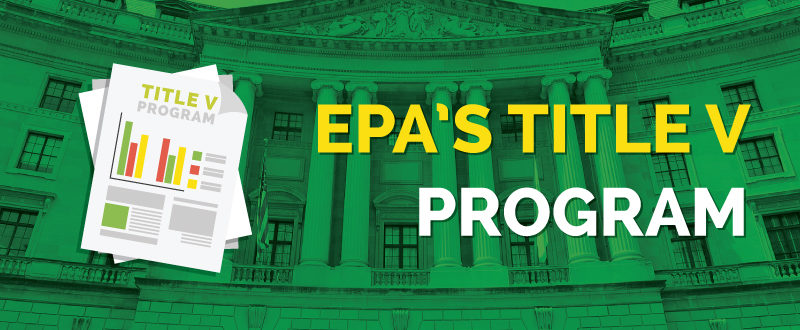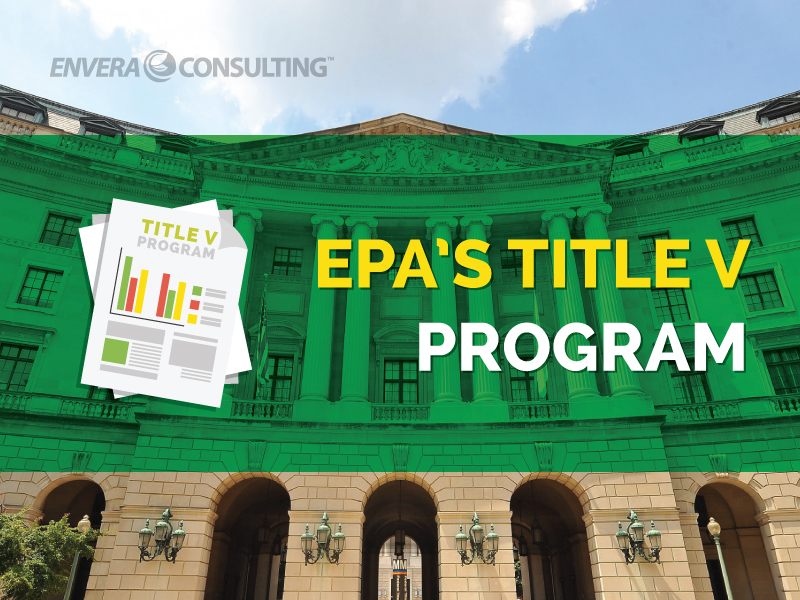

If you’ve only recently heard of Title V, you’ll have a much better grasp of the program after reading this post. Title V, which generally applies to larger facilities, is the Environmental Protection Agency’s permit program for stationary sources of air pollution.
Facilities subject to Title V must obtain a Title V permit, meet specific requirements, and are subject to more scrutiny and enforcement provisions as a means to ensure compliance with the Clean Air Act. The following information is particularly important for those facilities that fall in the gray area of whether or not they are subject to Title V.
For the curious, the program’s name comes from the 1990 amendments to the federal Clean Air Act, which describes the program in its fifth title — hence, Title V (pronounced, “Title Five,” as in the Roman numeral, not “Title Vee”).
Title V made three significant changes to the way facilities comply with air quality regulations, in that it requires facilities to:
- hold an operating permit
- submit compliance reports
- undergo enhanced enforcement provisions
Operating Permits
Title V introduced the concept of a facility, or operating, permit to the world of air quality regulations. Before then, facility permits related to air quality were not used, although similar permits were used for water quality regulations during the time that Title V was proposed. Title V permits were created to ensure and enforce facility compliance with all applicable requirements of the Clean Air Act.
One of the benefits of a Title V permit is that it compiles all of the facility’s compliance obligations into a single document. Before Title V, all such requirements were scattered throughout various state, local, and federal regulations, which made tracking them all a complex process. That also means that, prior to Title V, if a facility operated with ten pieces of permitted equipment, then that facility would have been required to have ten individual permits. So you can be thankful for just how much Title V has simplified the permitting process.
Compliance Reports
Facilities in the Title V program must submit periodic compliance and monitoring reports to the EPA, to show which regulations have been met and which have not. The reports also tell the agency if a facility has been collecting the data required to demonstrate compliance. An official responsible for the facility must certify under perjury of law whether or not a facility is in compliance. Misinformation or noncompliance can lead to legal action if the facility has ongoing compliance issues.
Reporting also greatly enhances the ability of federal and state agencies to assess a compliance situation for a Title V facility and take enforcement action, if one is needed.
Enforcement Provisions
Unlike the first two points already covered, this change originated in Title VII of the 1990 Clean Air Act amendments, but it remains applicable to the Title V program. As mentioned in the previous section, compliance at a Title V facility is more readily enforceable than at a non-Title V facility. But it’s not only the EPA who can take an enforcement action. Under Title V, public citizens can also seek penalties against facilities that do not comply with the Clean Air Act.
When it comes to implementing the Title V program, federal regulations (commonly referred to as “Part 70” because they can be found in that part of the Code of Federal Regulations) require that a local air-permitting authority submit for approval a program to implement the Title V program. Upon approval of the program, the EPA delegates the local agency the authority to implement the Title V program. For a large part of Southern California, that local agency is the South Coast Air Quality Management District (SCAQMD), which rolls up all the Title V-related rules under Regulation XXX (30 in Roman numerals).
Next week’s post will take a deeper dive into what criteria make a facility applicable to Title V and major source thresholds (including what “major source thresholds” means).